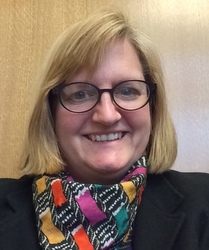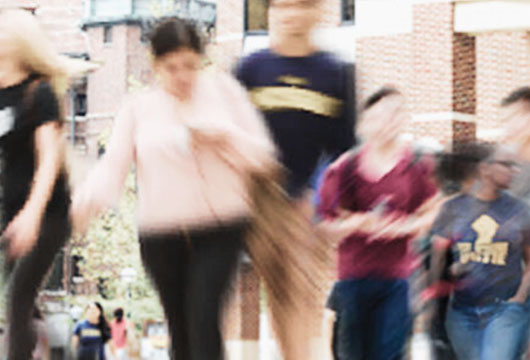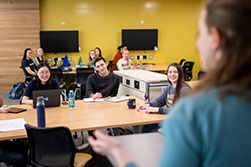How do undergraduates experience the learning environment and broader campus climate at U-M? Of course, teachers regularly gather information about such questions from their direct interactions with students. The campus-wide UMAY survey offers a broader, systematic way of collecting and tracking student perceptions about their learning and their more general experience of U-M. In this post, guest blogger Karen Zaruba of the Office of Budget & Planning describes some of the rich findings generated by the survey and highlights reasons you might encourage your students to complete it.
Have you heard about the University of Michigan Asks You (UMAY) survey? Just as important: Have your students heard about it?
 Sponsored by the Office of the Provost, the UMAY survey is the university’s annual effort to learn more about the undergraduate experience on our campus. Each spring, we invite all undergrads (regardless of class year) to respond. We want to know how they are doing as students, and how we are doing as an institution.
Sponsored by the Office of the Provost, the UMAY survey is the university’s annual effort to learn more about the undergraduate experience on our campus. Each spring, we invite all undergrads (regardless of class year) to respond. We want to know how they are doing as students, and how we are doing as an institution.
The survey questions cover a lot of ground: self-assessment of skills and growth since enrolling, perceptions of climate, use of time, academic engagement, and goals. Students report on their satisfaction with their experience in the classroom, academic department, and on campus overall, including their participation in research, study abroad, internships, service learning, and other high-impact learning activities. There are over 600 items in all (though no student has to answer all of them: some questions are randomly assigned). This broad range of items enables us to assess program effectiveness, benchmark with other universities, and gather unique insights about students' experiences.
To get a flavor of the kinds of things we can learn, here are some findings from the 2013 UMAY survey:
- 86% of students report that faculty provide prompt and useful feedback on student work.
- The majority of U-M students complete at least half of their assigned reading. However, there are differences by gender: 79% of female students do, while just 68% of male students report the same.
- 43% of students said they chose their major in part because it provides international opportunities.
- 65% of students agree that they have trouble remaining focused on academic work due to personal use of technology. However, those students who never bring a laptop or tablet to class do better: just 53% agree.
- First-generation college students are more than twice as likely as others to report that family responsibilities are a frequent obstacle to their academic success.
- By senior year, LSA student report their greatest gains in understanding a particular field of study, understanding international perspectives, and research skills. They report the lowest gains in quantitative skills, speaking skills, and fine arts appreciation.
As these examples show, some of the most interesting and useful findings come when we drill down into the data and filter responses to analyze just students who are (for example) underclassmen, majors in a particular field, students who entered as transfers, international students, first-generation students, women in STEM fields, students who are participating in research with a faculty member, or some other group. We obtain a more accurate and detailed picture of undergraduate experiences when we have sufficient student participation to support this kind of analysis.
Simply put, broader participation yields more useful data. Of course, we realize that U-M students have demanding schedules, and they often receive requests to fill out surveys. It can be hard to get their attention. But the more they hear about UMAY, particularly from staff and faculty they know, the more likely they are to believe it’s worth their time and effort.
If you’re interested in helping, mention UMAY to the students you teach, advise, supervise, and mentor. The survey is still open, and we are seeking many more responses; fewer than 1 in 10 students have responded thus far. What can you do?
- Though Winter term classes have ended, you might remind students of the UMAY survey when you encourage them to fill out their course evaluations.
- Consider posting a link to the survey as an announcement on your CTools site or writing a reminder on the board of your classroom where students take their final exam.
- If you are teaching any courses in the spring term, or supervising undergraduates in research or independent study, you can also encourage them to complete it. It will stay open through June.
Here's a blurb you're welcome to share: "Please help U-M to be the best it can be! Give us your feedback on your undergrad experience, and take the opportunity to tell us how to improve. We're awarding 30 $100 prizes to randomly-selected students who complete the survey. All currently-registered undergraduates, regardless of class level, are eligible. To take the survey, see the latest response rates by school/college, and find out more about UMAY, click here.
 Faculty can go to the same link to learn more about the UMAY survey: http://umay.umich.edu. If you have any questions, or want help with language or graphics to promote the survey, feel free to contact me at kzaruba@umich.edu.
Faculty can go to the same link to learn more about the UMAY survey: http://umay.umich.edu. If you have any questions, or want help with language or graphics to promote the survey, feel free to contact me at kzaruba@umich.edu.
Karen Zaruba
Assistant Director for Enrollment Management & Student Surveys
Office of Budget & Planning, University of Michigan
For more on the use of UMAY data to improve teaching and learning at U-M, see this University Record article.
- Log in to post comments
- 58 views






